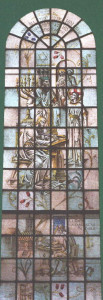And All That Heard Him Were Astonished At His Understanding

For three days after the close of the feast of the Passover, when Jesus was twelve years old, His parents sought His whereabouts in the city of Jerusalem only to find Him conversing with the scholars in the Temple. In the third window, Mary and Joseph look in on a temple setting artistically accomplished by the inclusion of four major components: the Mogen David, or Star of David, symbolizing a new hope for the Jewish people; the Menorah, the original seven-branched candelabrum found in the Temple in Jerusalem, which has come to stand for the light, warmth and sympathy of the Synagogue; the Torah, or Pentateuch, which represented the Hebrew scriptures and was composed of the first five books of the Old Testament; and the linen curtains which concealed the Holy of Holies where the Ark of the Covenant had rested.
The lower portion of the window profiles the outside of the Wartburg Castle where Luther, garbed in knightly attire and living under the assumed name of Squire George found refuge from capture as a condemned heretic, “subverter of all law and a devil in human form.” Luther called the Wartburg his Patmos after the city where St. John is said to have written the inspired text of the Apocalypse, because of the many visions and hallucinations he experienced there. One such confrontation reportedly caused Luther to throw his inkstand at the Devil, leaving the famous stain which draws tourists to this day.
While at the Wartburg, Luther undertook the monumental task of translating the Bible into German, from the original Hebrew and Greek. When completed, its extensive dissemination was due to the invention, some years earlier in 1452, of the movable-type printing press by Johann Gutenberg, which provided the broadest possible forum for the teachings of Reformers like Luther, and served as one of the most efficient weapons in the religious struggle. Luther’s work reached its climax with the signing by many of the German rulers of the Confessio Augustana, the Augsburg Confession, in 1530.
Back to Window #2 | Forward to Window #4
